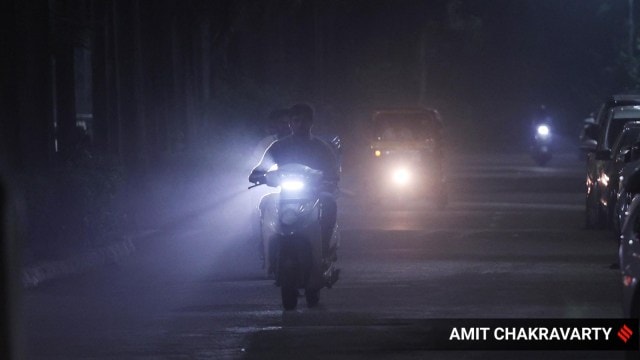With BKC at 375 and Colaba at 346, air quality plummets in Mumbai day after Diwali
Since the withdrawal of monsoon, Mumbai's air quality has been worsening, but on Tuesday it breached the 200-mark. The worst AQI was recorded in Bandra Kurla Complex at 375.
 Since October 10, Mumbai's air quality has been on a downward spiral with the AQI hovering between 100 and 200 over the past two weeks. (Express Photo by Amit Chkaravarty)
Since October 10, Mumbai's air quality has been on a downward spiral with the AQI hovering between 100 and 200 over the past two weeks. (Express Photo by Amit Chkaravarty)Amid Diwali festivities, the overall Air Quality Index (AQI) in Mumbai deteriorated significantly, plummeting to 212 and entering the ‘poor’ category Tuesday morning as the city woke up to a blanket of thick haze and smog.
This is the worst air quality logged in the city since the withdrawal of the monsoon on October 10, with at least three pockets recording ‘very poor’ (AQI over 300) and 10 pockets witnessing ‘poor’ air (between 200 and 300).
An AQI reading between 0 and 50 is regarded as ‘good’, 51-100 is ‘satisfactory’ (green), 101-200 is ‘moderate’ (yellow), 201-300 is considered to be ‘poor’ (orange), 301-400 is ‘very poor’ (red) and above 400 the AQI is ‘severe’ (maroon).
Since October 10, Mumbai’s air quality has been on a downward spiral with the AQI hovering between 100 and 200 over the past two weeks. However, on Tuesday it breached the 200-mark. The significant dip came a day after Diwali festivities, which saw large-scale bursting of crackers across the city. The release of pollutants as well as the setting in of slower wind patterns associated with winter season together contributed to the spike in air pollution levels.
3 pockets breach 300-mark
According to the Central Pollution Control Board (CPCB), AQI at 212 can cause breathing issues in most people upon prolonged exposure. Data from the CPCB dashboard showed that at least three pockets breached the 300-mark with the worst AQI recorded in Bandra Kurla Complex, which neared the 400-mark, at 375. This was followed by Colaba which logged an AQI of 346, while Mazgaon recorded 309 on Tuesday morning.
Meanwhile, at least 10 pockets across 28 monitoring stations recorded poor AQI over 200, of which the worst was observed in Malad West at 281, followed by Deonar (276), Worli (270) and Byculla (266). All other stations in the city recorded ‘moderate’ AQI between 100 and 200.
Sounding alarm bells, experts have indicated that the city is poised to experience further worsening of air quality in the coming weeks owing to the La Niña condition which is a climate pattern characterised by the cooling of surface ocean waters in the equatorial Pacific Ocean. During La Niña, atmospheric circulation changes, resulting in reduced wind speeds that prevent pollutants from dispersing quickly, and causing them to linger longer in the air, particularly in coastal cities like Mumbai.
Gearing up for an uptick in pollution levels, authorities from the Brihanmumbai Municipal Corporation (BMC) and the Maharashtra Pollution Control Board (MPCB) have kicked off a slew of pre-emptive measures such as setting up ward-level monitoring rooms to deploying mobile monitoring vans. Recently, the civic body also held meetings with builders’ bodies, directing them to implement pollution control measures at work sites.







